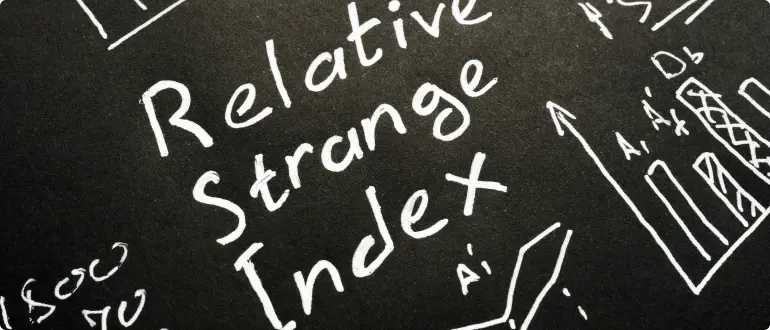Indicator RSI: what is it, how is it calculated, how to read it on FxPro

Table of Contents
- Trends are vital
- Repetition
- Prices can change easily
- What is the RSI Indicator?
- RSI Calculation
- How to use the RSI Indicator
- Using RSI in Forex
- Trade Entry
- RSI Success
- Stop Loss
In this article, we will discuss everything there is to know about the RSI (relative strength index) indicator, why so many traders use it, how it works and several other elements. However, before we take a close look at what the RSI is, we must have some understanding of what Technical Analysis is and its relationship with the relative strength index.
Essentially, technical analysis is a technique used to predict future market trends and price movements by analysing past market actions through charts and comparing them with present ones. The method focuses on what is and what could happen in the market. Technical analysis takes the prices of instruments into account and forms price charts, offering valuable data to traders.
One of the most significant benefits of technical analysis is that it allows experienced analysts to follow various market instruments at the same time. The method has three primary principals, which are essential to cover before delving into the RSI indicator.
Trends are vital
Traders use technical analysis to identify market behaviour patterns that carry some significance. Several given indications can produce predictable results and some recognised models are constantly repeated.
Repetition
Experts have been categorising forex chart patterns for hundreds of years. If you look at the repetition of these patterns, you will notice that the psychology of traders has not changed much.
Prices can change easily
For many years, experts have been keeping a close eye on price changes that occur in the forex market. They concluded that most changes occur because of demand and supply, market sentiment, and economic factors. Technical analysts however only focus on price movements and not on the factors that impact the changes.
The Relative Strength Index happens to be a critical indicator that analysts rely upon for better results. Lately, RSI trading has been gaining a lot of popularity because of its dependable formula and the use of RSI divergence.
What is the RSI Indicator?
The Relative Strength Index is a well-known indicator created by J.Welles Wilder. He was a technical analyst and developed the RSI for evaluating the forex market’s strength. The method shares some similarities to Stochastic trading strategies, mainly because they both identify oversold and overbought market conditions. They also scale figures from zero to hundred. In most cases, readings below thirty specify oversold market conditions and indicate the possibility of prices going up in the future.
Some traders tend to believe that oversold currency pairs are a sign that a falling trend could reverse, meaning that there could be a buying opportunity.
Readings above seventy highlight overbought conditions and the possibility of prices going down. Some forex traders believe that overbought currency pairs are a clear indication that the trend could reverse at any time. They interpret this as a selling opportunity.
Besides the oversold and overbought indications discussed above, traders also search for centreline crossovers in RSI indicators. Any movement that occurs under the centreline (fifty and above) signifies a rising trend.
A centreline crossover only increases when the Relative Strength Index value goes over the line of 50 and moves towards the 70th line on the scale. This is a sign that the market trend is strengthening, and traders perceive it to be a bullish signal. However, they only have this perception until it reaches the line of 70.
Any movement below the centreline (fifty or under) shows that a trend is falling. Falling or decreasing centreline crossovers frequently happen when RSI values cross below the line in the middle and move down towards thirty. This shows that the market trend is getting weaker. Traders refer to this as a bearish signal; that is until the relative strength index returns or goes above thirty.
RSI Calculation
To calculate RSI you need to have a great deal of technical expertise. If you want to understand how experienced analysts and traders accomplish these calculations, we suggest reading ‘New Concepts in Technical Trading Systems’, which is quite popular in the forex world and other forms of trading as well. While there is a fair bit of complexity involved in these calculations, a relatively simple formula breaks down the index to make things slightly more understandable.
RSI = 100 [100 / (1 + (Average of Upward Price Change / Average of Downward Price Change)]
According to tradition, the RSI is preferable to signal overbought conditions when they are over seventy and oversold conditions when they are below thirty. However, these levels are adjustable to fit the particular security price movements that a trader is monitoring.
For instance, if a security’s relative strength index frequently hits below thirty and over seventy, and fails to predict price trend changes, a trader would likely make readjustments by taking the lower end down to twenty and the upper end to eight, to attain more reliable signals.
Traders must remember that whenever there are periods of strong trends, the price of a security could continue to increase for an extended period. The same applies to downtrend price movements that could occur way after a market’s overvalued RSI indications.
How to use the RSI Indicator
As we discussed earlier, RSI indicators can help to improve your judgment regarding whether you are getting ideal prices. However, it will not reveal everything. Sure, the method provides you indications about whether the asset you are buying is oversold or overbought, but it doesn’t mean that the prices will go down immediately. In some cases, they do not decrease or increase at all.
Do not use the information that these indicators provide as a guarantee. Instead, use them as a crutch to identify possible trend reversals. Combine them with various other pieces of information and signs that you collect during your research. Talk to any experienced trader worth their salt, and they will tell you that trading with one indicator is not a wise choice. You must develop your skills around numerous other signals and data to see the bigger picture.
RSI happens to be one of many tools that could provide you with an edge in the vast forex market. You can utilise these tools to your advantage in several ways and can implement these indicators to your forex trading strategy. However, you should only incorporate them when you have a clearer understanding of whether you are receiving a favourable sell or buy point. This is an excellent way to find out if you are getting out at an appropriate time.
Using RSI in Forex
Let us discuss some helpful tips for using RSI in forex trading to make your trading experience more successful.
Trade Entry
Before entering an RSI trade, you must observe the signal that your indicator is showing. It could be oversold, overbought, or even a divergence pattern. If you plan to enter the market at any of these patterns, it would be best to sell or buy the currency pair as soon as the price action leaves the indicator’s respective threshold.
In case you plan to trade divergence with the indicator, it would be a good idea to enter a trade after the price action continues a couple of candles in your intended trades direction.
RSI Success
According to basic relative strength index rules, you should hold your trade and wait until your RSI indicator gives you an opposite signal. Once again, it could be bearish, bullish, oversold, or overbought signals. However, when you look at things practically, taking your full or partial profits earlier using a trailing stop loss or utilising price action-based rules makes more sense.
Stop Loss
As we discussed initially, RSI indicators do not always provide accurate signals, especially when you use them without any other data or tools. Experienced traders claim that using a stop loss with other pieces of information could offer protection from your trades going awry.
The ideal place for a stop-loss order is ahead of recent swings. These swings can either be top or bottom and likely, formed during a reversal.
There are plenty of other ways to utilise RSIs in forex, but the methods detailed in this article are what most traders use because of their success rate.




